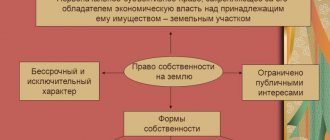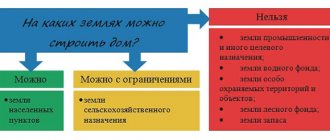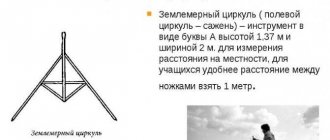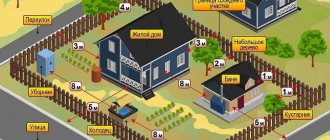Types of land rent. Photo: sunhome.ru
Editorial
Promdevelop editorial team
Due to the presence of natural resources on the earth and in its depths, which cannot exist in isolation, the use of the presented capital factor in economic activity is accompanied by the payment of rent payments - land rent.
- How does rent differ from rent and sale?
- Benefit of land rent
Income from such land use belongs to the person who owns the land by right of ownership, and all types of relevant transactions and operations are carried out in strict accordance with the norms of current legislation.
The essence of ground rent
The owner of a land plot has the right to dispose of it at his own discretion, including transfer for temporary use to third parties (both individuals and legal entities, Article 22 of the Land Code of Russia). The relations arising as a result of such a transfer are called rental, and the rent paid by a temporary user is ground rent (Article 583 of the Civil Code of Russia).
Submitted payments must have the following characteristics:
- Have no connection with the business activities of the land owner;
- Be of a regular nature or represent a one-time rental payment for a specified period of time.
Important! Land owners will not receive rent at all if they use it for personal purposes, without transferring it to third parties for use.
Other types of income
Linear income
Characteristic of traditional types of business, that is, trade, services and the rest. Implies periodicity. That is, if a person works in a company for a month, he receives a salary once, if for a year - twelve times. If a person works in a factory with a piece rate wage, then for one job he receives one amount, for a hundred parts - the same amount multiplied by one hundred.
Gross income
This is the total income from sales of goods, interest, dividends and other possible sources. Usually applied to the state in general.
Personal income
Money that comes to the disposal of a specific person. In addition to the actual salary, personal income can include any dividends, interest, and so on. Personal income is positioned as an important component in assessing family income as a whole. This indicator is used to shape the behavior of firms in the market.
Total income
This is the total profit from all possible sources over a certain period of time. When calculating it, no gradation of sources is used.
Non-operating income
This is income in progress
- Product sales
- Participation in share business
- Investments
- Transactions with currency
- Fines
- Rentals
- Patent operations
- Lending
- Use of free services
- When revaluing property...
Passive income
It comes even in situations where no effort is made on the part of the recipient. For example, this could be income from assets.
Active income
As opposed to passive, it is acquired through certain actions over a specific time. This includes a person’s salary, the income from the work process for hire, and the “coven.” Usually happens for a specific action. One of the advantages is the opportunity to get quick income for a specific activity.
Land rent factors
Land rent factors influence the difference between rent and wages, profits and interest. Many economists, including D. Ricardo, K. Marx and A. Smith, worked on the issues of distinguishing the concept of rental payments from wages, business income and profits from securities transactions.
All cash payments presented relate to income, and the main factor that differentiates them is the source:
- Remuneration is the monetary equivalent of labor power, i.e. the source of wages is human labor;
- Profit is a type of income (absolute (normal) - i.e. without deducting costs, and net (economic) that a subject receives in the course of business activities;
- The source of interest is the provision of funds for use by third parties (individuals (for example, a loan issued by a bank) or legal (for example, depositing money in a banking institution);
- Rent is received as a result of the provision of land plots, natural resources, the quantity of which is limited and is not subject to man-made renewal, or other property for temporary use, i.e. ground rent is income from renting out land.
Land market
Among all factors of production, land and other natural resources, many of which are limited and irreplaceable, occupy a special place.
Natural resources act as a factor of production, used in kind, and as a space in which production activities are carried out.
All natural resources can be divided into renewable (forests, artificially created water basins) and non-renewable (land, minerals).
As non-renewable resources are depleted, the market conditions for production factors change and the cost of disappearing resources increases.
Land, which is a means of production, is a necessary material prerequisite for the labor process, the main material factor. The importance of land varies across different industries. Thus, in the manufacturing industry, land provides the site for the enterprise in which it is located, as well as the scope for the production process. In the extractive industry, land also provides an object of labor that turns into raw materials.
Pricing on the land market
Owning land is associated with known benefits and costs, the comparison of which will determine the advisability of maintaining the property or its alienation. Owning land, the owner does not use other possible options for generating income, for example, he could not buy land, but put money in the bank at interest.
In this regard, the landowner's income can be calculated as the ratio of the rent received to the market interest rate.
Land price = Annual rent / Interest rate
The price of land shows how much money needs to be deposited in the bank in order to receive an income equal to the given land rent at the current market interest rate.
The amount of land rent is formed as a result of the interaction of supply and demand on the land market.
The specificity of the land market is that within the national economy, the supply of land and natural resources is absolutely inelastic , since the amount of resources is a fixed quantity.
Demand for land shows how much land is willing to rent at various possible levels of payment for it. If rents are high, the amount of land available for rent will be less than if rents are low.
The demand curve for land is identical to the marginal revenue curve for land. The marginal income of land depends, in turn, on the productivity of the natural resource. When rents are high, only very productive land can be leased, since only a high marginal income can pay high rents and possibly provide a profit for the tenant. With a decrease in land rent, even less productive lands will be rented.
Ground rent profit
Article 583 of the Civil Code of Russia indicates that the parties to rental legal relations have the right to independently determine the form of expression of the corresponding payments, the form of profit (monetary or otherwise - part 1 of Article 583 of the Civil Code of the Russian Federation). In accordance with the above, the following forms of profit from rent are distinguished:
Natural , i.e. expressed by goods (products). It is used primarily when using leased land for agricultural purposes (for example, when growing wheat on such land, the rent payment is part of the harvest);
Labor , in which a temporary user, as payment, undertakes to perform (perform over a certain period of time) specified work (provide a service) in favor of the land owner;
Monetary , in the conditions of application of which the rental payment is represented by a monetary amount agreed upon between the parties.
Forms of ground rent
In addition to the form of rental payments, it is necessary to distinguish types of land rent, the differentiation of which is carried out depending on the terms of payment for the rent of the land plot.
Forms of land rent. Rice. 1: gosjurbyuro58.ru
Absolute land rent
With absolute land rent, the temporary user undertakes to pay regardless of the size of the plot of land used in the leased land, as well as regardless of its fertility (saturation with natural resources). In the presented conditions of land rent, the profitability of production must cover the rent and other costs, i.e. the tenant is forced to ensure the receipt of excess profits.
Monopoly land rent
Monopoly rent of a land plot occurs if the leased plot has specific qualities, as a result of which a temporary user has the opportunity to grow special types of crops on it with subsequent sale at a monopoly price. The amount of such land rent depends on the inflated cost of the products received and the corresponding percentage agreed upon between the parties to the land rent agreement.
Differential rent 1 and 2
Differential land rent is an additional profit, the receipt of which is due to a more favorable location of land in relation to strategically important objects (for example, sales points), as well as from additional production investment.
The division of differential land rent in the economy into two groups is essentially conditional and, in practice, difficult to separate.
Differential ground rent 1 is a payment based on the location of the leased plots, and differential ground rent 2 depends on additional investments (capital or labor).
Receipt forms
During feudalism, income was received in several forms: cash, in kind and labor.
Monetary
The emergence of the monetary form was a consequence of the transition of feudal land ownership to capitalist property. It represents the direct receipt of profit in finance and the third stage of the development of feudal rent.
Natural
Rent in kind or product rent is a converted form of labor rent. In the old days, peasants gave most of the products they produced in kind to the landowner. This part was called natural quitrent, and sometimes it could even reach up to 80% of the total harvest.
In comparison with the labor type, this form opened up a much greater opportunity for the stratification of the serf peasantry . Its beginnings took place even when natural relationships dominated.
Conditions of ground rent
Speaker - Nikolay Patskov, General Director of Document Constructor FreshDoc.ru.
According to Article 583 of the Civil Code of the Russian Federation, a annuity agreement is an agreement under which one party (recipient) transfers ownership of property to another party (payer). The payer, in turn, undertakes to periodically pay the recipient a certain amount of money or provide his maintenance in another form. The object of alienation can be any property, but in practice, real estate (houses, apartments, land plots) is usually transferred for payment of rent.
Expert Nikolay Patskov
In this article we will talk about the nuances of registering ground rent: when it is applied, how it differs from other transactions, what clauses of the contract you need to pay special attention to.
How does rent differ from rent and sale?
A land rent agreement has common features with lease and purchase and sale agreements, but at the same time it has special features that distinguish it from related transactions. For example, rent differs from lease in that it provides for the transfer of ownership of a land plot to the payer of rent payments. When leasing, the tenant receives the right to use the property, which remains the property of the lessor. In addition, a lease agreement is always concluded for a certain period, and the rent can be indefinite (permanent) or for life.
An annuity is distinguished from a purchase and sale agreement by the absence of a specified total amount of payments in the agreement. At the time of entering into the transaction, the parties cannot know how long the permanent or lifetime annuity will last. In the first case, the payer can buy back the annuity at any time, and in the second case, it is unknown how long the annuitant will live.
Types of land rent
The law provides for three types of annuity - permanent, lifelong, and lifelong maintenance with dependents.
- A permanent annuity provides for an indefinite payment of rent payments; the rights of the annuity recipient can be transferred to other persons by assigning a claim and passed on by inheritance (Articles 583 and 589 of the Civil Code of the Russian Federation).
- Life annuity - the recipient transfers property to the payer in exchange for regular lifetime payments of a certain amount.
- Lifetime maintenance with dependency is a type of lifelong annuity, according to which the payer is obliged, in addition to paying the rent, to provide for the needs of the annuity recipient and/or a third party specified by him (clean the apartment, buy food and medicine, pay for utilities).
Recipients of a permanent annuity can be citizens and non-profit organizations, but only citizens can receive a life annuity. Payers can be citizens and legal entities.
An example of a transaction: a citizen alienates a plot of land owned by him, and in return receives the right to a monthly constant rent in the amount of 30,000 rubles. Thus, he provides additional income for himself, and in the future for his heirs. The parties determine the amount of rent payments based on the market value of the plot.
Land rent agreement
Regardless of the type of annuity, the agreement is subject to mandatory notarization, and the transfer of ownership is subject to registration in Rosreestr. The agreement must indicate:
- subject - description of the alienated land plot (location, area, cost (if the property is alienated for a fee);
- the size and form of the annuity - the amount and frequency of payments, and in the case of lifelong maintenance with dependents - also a closed list of social assistance services;
- annuity redemption price (for permanent annuity contracts).
In addition, the agreement should specify the procedure for terminating the annuity. It must be remembered that a lifetime annuity is established for the life of the citizen transferring the property for rent, or for the life of a third party indicated by him. As a general rule, the obligation to pay the annuity ceases at the death of the recipient, and the right to claim overdue payments is subject to succession. Unlike a life annuity, a permanent annuity does not end with the death of the parties - obligations under the contract are inherited. In addition, the payer can buy out a permanent annuity.
Risks of a ground rent agreement
Rent is an aleatory, that is, risky transaction, so when registering it you need to be careful and attentive. Let's consider the risks that parties to an annuity agreement may face:
- Claims from relatives. If the rent recipient does not get along with his relatives and transfers the land plot under a rent agreement, after his death, dissatisfied relatives may try to sue this plot from the new owner. For example, they may claim that the annuitant did not understand the consequences of the transaction. To insure against such accusations, before concluding a contract, you should request a certificate from a psychiatrist confirming his full legal capacity from the annuitant. If such a document is available, it will be almost impossible to invalidate the transaction.
- Termination of the contract by the annuity recipient. There is always a chance that the annuitant will try to terminate the contract on the grounds that the payer is not fulfilling his obligations. If the court agrees with it, the payer will lose the right of ownership, and payments already paid will not be returned to him. It is impossible to completely insure against such developments, but the risk can be reduced if you document all expenses and save checks, receipts and receipts confirming the fulfillment of obligations.
- Falling prices for land. The value of the plot may decrease, for example due to the economic crisis, as a result of which the transaction will become unprofitable for the payer.
- Inability to determine the exact amount of rent. A life annuity agreement does not have a specific term, which means it does not insure against overpayments.
- The annuitant may live an indefinite number of years after the conclusion of the transaction or outlive the payer (then, it is likely that his heirs will have to pay the annuity).
Definition of annuity and brief classification
Rent is a concept that is used in several senses and meanings, depending on the application, but we are interested in its economic meaning.
Economic value - a constant type of income, indexed in accordance with inflation processes, received from land, capital or other types of property.
There are two parties involved in the process - the owner of the resource ( rent rent payer for use . The transfer process and terms of use are formalized in the form of a bilateral agreement. In this case, the recipient is obligated to pay the cost of the transferred property or otherwise provide for the maintenance of the owner.
From the point of view of obligations, the contract is one-sided, since the owner has no obligations under it after the transfer. After the transfer of property, the new owner has the right to own and dispose of the resource, use it for commercial purposes and perform other actions provided by law.
Rent classification :
- Land – the cost of using land and other types of natural resources, divided into:
- absolute - surplus value is formed exclusively due to the monopoly right of ownership;
- differential - the surplus is formed by improving working conditions, cultivating the land and investing additional funding in it.
- Financial – a sequence of regular payments of a fixed amount.
- Economic - a type of rent determined by payment for resources, the quantity of which is limited on the market. It is calculated as the difference between the price of labor and the cost of goods.
- Dead – funds received for resources that are not used.
- Constant - the contract does not imply an end date for payments, only their frequency.
- Life annuity is the most common form of annuity in real estate, where the owner receives a guaranteed regular income, and after his death, the property passes to the second party.
- Insurance – when periodic payments in favor of the policyholder are made by the insurer.
- Natural - excess income generated when the profit caused by invested labor or capital exceeds the usual level.
- Monopoly - excess income generated by a successful confluence of market factors that make it possible to inflate prices for products.
Rent is a complex concept that a novice entrepreneur must take into account if he assumes the presence of this source of income or expense. For competent business planning, download from our website a complete ready-made business plan, including calculations of key economic and financial indicators. Or order an individual turnkey business plan, which will reveal the features and main nuances associated with opening a specific enterprise.
We also recommend that you read the article Net profit of an enterprise: calculation formula, difference from profit. Net profit is determined within the framework of the Profit and Loss Statement.
Capitalization of ground rent
The land rent capitalization method is one of the methods for calculating the value of a plot leased separately from buildings and structures, which takes into account the potential profit of the buyer from the use of the land based on the income received by the current owner and the capitalization ratio (Order of the Ministry of Property No. 568-r dated March 6, 2002).
In other words, capitalization of land rent is the determination of the total value of future rental payments, equal in value and determined at the time of the assessment.
Ground rent price
According to the method presented above, the price of land (as present value) is determined by the following formula:
Land Price = Net Income / Capitalization Rate
Net income will be represented by the amount of rental payments received by the owner over a certain period (for example, annually). Capitalization rate is the market interest rate.
Ground rent capitalization method - calculation example
The owner receives annual rent payments in the amount of 10,000 Russian rubles. The capitalization rate is 23%. Let's calculate the cost of the plot (land price) using the capitalization method:
10,000/23%= 10,000/0, 23 = 43,478 rubles.
Price of ground rent. Rice. 2: 900igr.net
A little about calculations
Net income is calculated by subtracting from the money received the cost item used for the production and sale of a specific product.
Net present value. The entire amount of expenses is taken and subtracted from the entire amount of income at a specific point in time.
Operating income. This is gross profit minus operating expenses.
Example:
An entrepreneur bought goods for 400 thousand rubles. And he spent 200 thousand rubles on housing and communal services, renting premises, paying taxes and the salary fund. At the same time, the goods were sold for the amount of 800 thousand rubles.
We calculate net income: 800 thousand – 400 thousand – 200 thousand = 200 thousand.
This means that the entrepreneur’s profit will be 200 thousand rubles.
Rent payment, standard value of land and land tax
The Land Code of the Russian Federation establishes the basic principles of land use, the first place among which is occupied by the principle of payment. There are three types of payments associated with the use of land:
- Rent;
- Land tax;
- The price of the plot, which depends on its qualities and location.
Standard land value is a value that characterizes the price of a plot with its specific qualities and a certain location, when calculating which the potential profit for the payback period is taken into account.
The payment of tax for land is due to its special status - recognition as a national value, in connection with which the main owner is the state, as the personification of the entire people.
Important! Ground rent and rent act as a special and general concept, respectively.
Rent is applied in the field of civil law relations between the owner of the site and its temporary user (tenant), and its payment is based on the provisions of the lease agreement concluded by the represented parties.
Rent and land cost
In practical activities, rent relations are associated with the mechanism for the formation of land rent and land prices. Rent is actually the price for the use of land, the cost of the land user. If the leased land does not have any elements of fixed capital, then the rent and rent are quantitatively the same. If such elements are present, then the rent consists of rent, interest on capital and depreciation charges.
The price of land is capitalized ground rent. Because the sale of a land plot is at the same time the sale of the rights to receive income from it, then the price of a land plot can be presented in the form of the discounted value of future land rent:
Figure 1. Formula. Author24 - online exchange of student work
Where Pt is the price of a land plot, Rn is the rent received in the nth year, i is the current interest rate, N is the number of years during which the land can generate income.
Basic principles of land use
In accordance with the provisions of Article 1 of the Land Code of Russia, the use of land must be based exclusively on the following principles:
- Payment for use;
- Security at the state level;
- Availability of intended purpose;
- Recognition as a key element of life;
- The right of individuals and legal entities to participate in resolving land issues, etc.
Interesting fact! The legislator places the protection of life and health of citizens in first place among the conditions of land use.
Land market and rent
Relations in the land market are represented by the conclusion of purchase and sale transactions between landowners and individuals (legal entities). A mandatory condition of contracts of this category is the price, the calculation of which establishes a close relationship between the rent and the cost of the site.
The formulas used to determine the price of sale or lease of land include indicators of the nominal value (market price) and the total expression of rental payments. Thus, land rent in Russia directly affects the calculation of the market price of land and, on the contrary, the market price directly affects the cost of temporary use of land.
Interesting! The land market and land rent are factors that form the price of land. An increase in land rent provokes an increase in the cost of the site and vice versa.
The value of land resources - lawyer's commentary
Speaker - Lawyer of the legal service "Unified Center for Protection" Alena Zhupikova.
If we talk about a ground rent agreement, the legislator has not established distinctive requirements for the form and content of the agreement, therefore, when drawing it up, one should refer to the general rules of civil law applicable to rent agreements depending on its type, including the fact that the rent agreement is subject to notarization , and in the event of alienation of property, it must undergo the state registration procedure. The rules of purchase and sale, exchange, donation, lease, and other similar concepts related to rent may be applied to these relationships.
Expert Alena Zhupikova
Attention should be paid to the object of ownership itself - land, as well as to all the features arising from land legal relations.
Benefit of land rent
First of all, before determining whether land rent is profitable, it should be noted that there are 3 main types of land rent: monopoly, absolute and differential. In professional circles there is a theory that all types of rent are differential in one way or another, from which we can conclude that profitability directly depends on the value of the land. Land is certainly the most important resource for the state , which is a non-reproducible factor in the economy, has differences in the quality and fertility of the soil, territorial features of location, quantitative restrictions (land is always not enough), and also has its own purpose.
Land resources. Rice. 3: ppt-online.org
In addition, the value of land, together with its quality characteristics, also depends on agricultural demand (for example, for the development of farming), that is, on the demand for products that are produced using this land. There is also a non-agricultural demand for land, which can influence the profitability of land rent more than agricultural demand.
Why is this happening? On the one hand, the demand for products is always stable regardless of external factors, even when the land is of poor quality, and this contributes to an increase in the cost per unit of production.
However, on the other hand, the downward trend in agricultural demand for land is directly proportional to the increase in non-agricultural demand due to the desire of modern society for wealth and a “comfortable” life, as well as the desire to maintain this status as much as possible.
Thus, the reason for the growth of non-agricultural demand for land, and therefore the profitability of land rent, is that in modern society the need for land is rapidly increasing for the purpose of its further use for real estate development, and other related benefits (industrial production, social infrastructure, etc.).
Part II. What is land tax?
Land tax is one of the oldest forms of taxation and is known in one form or another to almost all states.
Currently, there are two conceptually different systems of land taxation. In countries such as Canada, the USA and some others, there is a principle of a single real estate tax, which is levied on buildings, structures and land plots on which such objects are located. Russia is characterized by a system of separate taxation of a land plot and objects on it through land tax and taxes on the property of individuals and organizations, which is due to historical prerequisites[1].
History of land tax
In Ancient Rus'
land was the main object of taxation and a source of replenishment of the state treasury. Initially, individual households with a certain number of stoves (hence the “smoke tax”), agricultural tools, and the ability to cultivate a given amount of land (plough) were subject to tribute.
Important! This tax was the main source of treasury income. Next we will see what percentage of the income of the consolidated budget of the Russian Federation the land tax now represents.
In the 16th-17th centuries
taxation was in effect. The plow tax applied to a separate farm with a plot of land, the conventional unit of measurement of which was the plow. The size of the plow depended on the quality of the land, its owner, and could also differ significantly depending on the region. In the middle of the 16th century, an inventory of lands and the solvency of the population was made, as a result of which a large plow with a standardized size became the unit of taxation[2]. The plow itself was divided into cheti (quarters), a certain space of land equal to half a tithe (approximately 0.5 hectares)[3].
In 1649
taxation was replaced by household taxation, in which fenced peasant and townsman yards were levied with household taxes. However, the Russian peasant quickly found a way out of the situation by using the first tax optimization mechanism - relatives and just neighbors united their yards with a single fence. One fence – one yard – one household land tax.
Russian empire.
Under Peter I, instead of a household tax, a poll tax was introduced in 1724, which existed for 150 years as a personal direct tax for men of certain classes, regardless of age, income and property. To determine the circle of taxpayers, a population census was conducted. During this period, the land tax lost its essential characteristic – its connection with the land[4]. Under Paul I in 1797, the size of the tax began to differentiate depending on the quantitative and qualitative characteristics of the land, as well as the income of its owners[5], but still retained its “per capita” nature.
Late 19th century
was marked by large-scale government reforms, including tax reforms. Thus, the poll tax was gradually abolished (80-90s of the 19th century), and a system of separate taxation of urban and rural lands was formed.
In 1863
in cities, an all-estate state tax on urban real estate was introduced, which levied urban lands and buildings and structures erected on them, and from 1875 a state land tax began to operate, which was separated from the state zemstvo tax and applied to lands outside urban settlements[6 ].
Initially, tax rates (salaries) were set according to an allocation system, that is, the Ministry of Finance determined the amount of tax required for the state budget and “allocated” it among the provinces. The province itself determined which part of the tax distributed to it from which part of the province, taking into account the value of the land, to collect. However, such a system did not reflect the constantly changing value of land, therefore, at the beginning of the 20th century, the Ministry of Finance ceased to determine the amount of tax and distribute it by province; tax rates began to be determined as a percentage of their value[7].
Soviet time.
The Decree on Land of 1917 abolished private ownership of land, and the Regulations “On socialist land management and measures for the transition to socialist agriculture” of 1919 established state and collective forms of ownership. The land tax was abolished, but until 1981 its role was played by such payments as agricultural tax and land rent.
In 1923, instead of the previous taxes, a single agricultural tax was introduced, which was levied partly in kind and in cash and was calculated depending on the number of eaters, livestock and yield. Since 1953, agricultural tax began to be calculated as an independent tax at rates per one hundredth of a hectare of land area. In settlements, according to Decree of the Presidium of the USSR Armed Forces dated April 10, 1942 No. 24 “On local taxes and fees,” land rent was collected at rates per square meter depending on the class of the settlement (I class - 18 kopecks, VI class - 4 kopecks) .
By the Decree of the Presidium of the USSR Supreme Council dated January 26, 1981 “On local taxes and fees,” land rent was transformed into a land tax with lower rates (Class I - 1.8 kopecks, Class VI - 0.4 kopecks). Subsequently, the land tax was regulated by the Law of the Russian Federation of October 11, 1991 No. 1738-1 “On payment for land.” The tax amount was established in the form of stable payments per unit of land area per year.
Present tense.
Since January 1, 2005, in accordance with Federal Law No. 141-FZ of November 29, 2004, land tax at the federal level is established by Chapter 31 of the Tax Code of the Russian Federation (RF), and at the local level - by regulatory legal acts of representative bodies of municipalities (Decision of the Chelyabinsk City Duma third convocation dated November 22, 2005 No. 8/11 “On land tax in the territory of the city of Chelyabinsk”, Decision of the municipality of the city of Yaroslavl dated November 7, 2005 No. 146 “On land tax”). In the federal cities of Moscow, St. Petersburg and Sevastopol, land tax is regulated at the regional level by regulatory legal acts of the specified constituent entities of the Russian Federation.
Accordingly, land tax is a direct local property tax, that is, a mandatory gratuitous payment that is paid to the local budget by individuals and legal entities with land plots in the relevant territory.
Tax regulation today.
The Tax Code of the Russian Federation establishes such mandatory elements of tax as:
— taxpayers;
— object of taxation;
- the tax base;
- taxable period;
— the maximum tax rate and the procedure for its establishment;
— tax benefits and tax calculation procedures.
The legislative bodies of municipalities (federal cities of Moscow, St. Petersburg and Sevastopol), in turn, determine:
— specific tax rates;
— features of determining the tax base
— additional tax benefits.
To simplify your search for information, we have prepared a convenient register for you: “Land tax rates and benefits: by region of the Russian Federation.” You can find and download it
Collection of land tax in Russia.
Revenues to the consolidated budgets of the constituent entities of the Russian Federation from land tax, according to statistics from the Federal Tax Service, amount to 182 billion rubles for 2021 and 40 billion rubles for the first quarter of 2021. At the same time, most of them fall on the share of organizations (139 billion rubles and 37 billion rubles, respectively)[8].
Remember, at the beginning of the article we wrote that in Ancient Rus' land tax was the main source of treasury income? Today, land tax is less than 2% of the revenue portion of the consolidated budgets of the Russian Federation...
In conclusion. According to the principle of the unity of fate of a land plot and objects firmly associated with it, land plots and buildings in civil circulation are considered as a single object, but currently they are subject to three separate taxes: land tax, property tax for individuals and property tax for organizations. Despite the fact that in the original version of the Russian Federation in 1998 there was a single tax on real estate and attempts were made to implement it as an experiment in Novgorod and Tver, the legislator abandoned this concept, and the land tax continues to exist as an independent tax[9].
According to many civil experts, we are also gradually moving to an understanding of real estate as a plot of land and everything that is located on it and is inextricably linked. The principle of unity of fate is already slowly penetrating civil legislation. True, very slowly. But when this happens, we hope that land tax will remain the only tax on real estate.
Follow our publications on this blog or on our company website: mitsan.pro
Sources: Regulatory legal acts 1. Tax Code of the Russian Federation (part two) dated 05.08.2000 No. 117-FZ. 2. Decision of the Chelyabinsk City Duma of the third convocation dated November 22, 2005 No. 8/11 “On land tax in the territory of the city of Chelyabinsk.” 3. Decision of the municipality of the city of Yaroslavl dated November 7. 2005 No. 146 “On land tax.” 4. Federal Law No. 110-FZ of July 20, 1997 “On conducting an experiment on real estate taxation in the cities of Novgorod and Tver.. 5. Law of the Russian Federation of October 11, 1991 No. 1738-1 “On payment for land.” 6. Decree of the Presidium of the USSR Armed Forces dated January 26, 1981 “On local taxes and fees.” 7. USSR Law of 08/08/1953 “On Agricultural Tax”. 8. Decree of the Presidium of the USSR Armed Forces dated April 10, 1942 No. 24 “On local taxes and fees. 9. Resolution of the All-Russian Central Executive Committee. On socialist land management and on measures for the transition to socialist agriculture (Regulations) dated 02/14/1919. 10. Decree of the II All-Russian Congress of Soviets 10/26/1917 “On land”. List of used literature: 1. Batashev R.V. Regional aspects of taxation of property of individuals: problems and solutions (on materials of the Chechen Republic) // Young scientist. - 2015. - No. 22 (102). — P. 344-346. — URL: https://moluch.ru/archive/102/23150. 2. Burova A.S., Vasilyeva E.G., Gubenko E.S., etc. Tax law: textbook for bachelors / ed. I.A. Tsindeliani. 2nd ed. M.: Prospekt, 2021. 528 p. 3. Danilova E.V. Development of land legislation in Russia in the first half of the 19th century: historical and legal research: dis. ...cand. legal Sci. Nizhny Novgorod. 2004. P. 27. 4. Zakharov V.N., Petrov Yu.A., Shatsillo M.K. History of taxes in Russia. 9th – early 20th centuries. M.: ROSSPEN, 2006. 5. Ilovaisky S.I. Textbook of financial law (4th edition). - Odessa, type-chromo-lithography by A.F. Sokolovsky, 1904 6. Grigorieva L.G. Taxation of real estate in Russia and abroad. M.: Editorial office of “Rossiyskaya Gazeta”, 2021. Vol. 11. 144 p. 7. Kirillov A.K. Russian financial system of the era of capitalism (second half of the 19th - early 20th centuries): Textbook. Novosibirsk: NSU, 2011. 178 p. URL: https://al-kir.ru/ssc/sk/index.html. 8. Pepelyaev S.G., Popov P.A., Kosov A.A. etc./Tax law. A special part. Textbook for universities / ed. S.G. Pepelyaev. M.: Education, 2021 -736 p. 9. Polenov, A. D. On the issue of tax reform: Review of systems of zemstvo land taxation (1865-1879): Comp. according to official documents A.D. Polenov.-St. Petersburg: type. and chromolite. A. Transhelya, 1880. URL: https://www.library.fa.ru/page.asp?id=981 10. Chernik, D. G. Ch.49 Theory and history of taxation: a textbook for academic undergraduates / D. G. Chernik, Yu. D. Shmelev; edited by D. G. Blueberry. - M.: Yurayt Publishing House, 2014.
[1] Grigorieva L.G. Taxation of real estate in Russia and abroad. M.: Editorial office of “Rossiyskaya Gazeta”, 2021. Vol. 11. 144 p. [2] Zakharov V.N., Petrov Yu.A., Shatsillo M.K. History of taxes in Russia. 9th – early 20th centuries. M.: ROSSPEN, 2006. 2 [3] Chernik, D. G. Ch49 Theory and history of taxation: a textbook for academic undergraduates / D. G. Chernik, Yu. D. Shmelev; edited by D. G. Blueberry. - M.: Yurait Publishing House, 2014. [4] Ilovaisky S.I. Textbook of financial law (4th edition). - Odessa, type-chromo-lithography by A.F. Sokolovsky, 1904. [5] Danilova E.V. Development of land legislation in Russia in the first half of the 19th century: historical and legal research: dis. ...cand. legal Sci. Nizhny Novgorod. 2004. P. 27. [6] Burova A.S., Vasilyeva E.G., Gubenko E.S., etc. Tax law: a textbook for bachelors / ed. I.A. Tsindeliani. 2nd ed. M.: Prospekt, 2021. 528 p. [7] Kirillov A.K. Russian financial system of the era of capitalism (second half of the 19th - early 20th centuries): Textbook. Novosibirsk: NSU, 2011. 178 p. [8] URL: https://www.nalog.ru/rn77/related_activities/statistics_and_analytics/forms/ [9] Pepelyaev S.G., Popov P.A., Kosov A.A. etc./Tax law. A special part. Textbook for universities / ed. S.G. Pepelyaev. M.: Education, 2021 -736 p.
Conclusion
Due to the special status of land as a national treasure, all actions of which it is the object (including land rent) should be carried out in strict accordance with the provisions of current laws and by-laws, including:
- Land Code of the Russian Federation;
- Civil Code of Russia;
- Federal Law No. 172 of December 21, 2004 (on the transfer of land from one category to another);
- Order of the Ministry of Property No. 568-r dated March 6, 2002 (on methodological recommendations for determining the market value of land plots).











